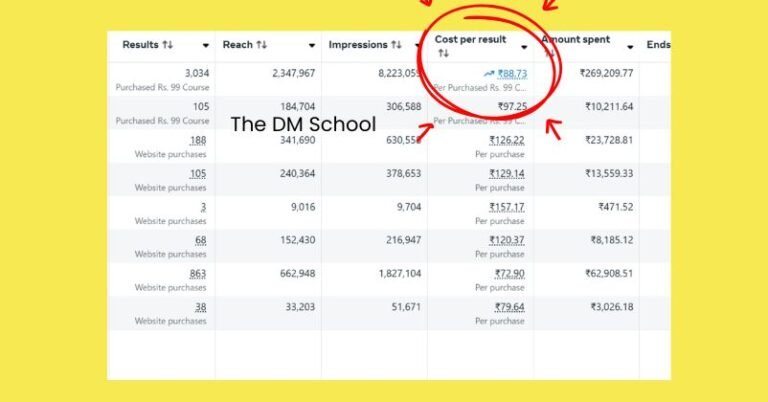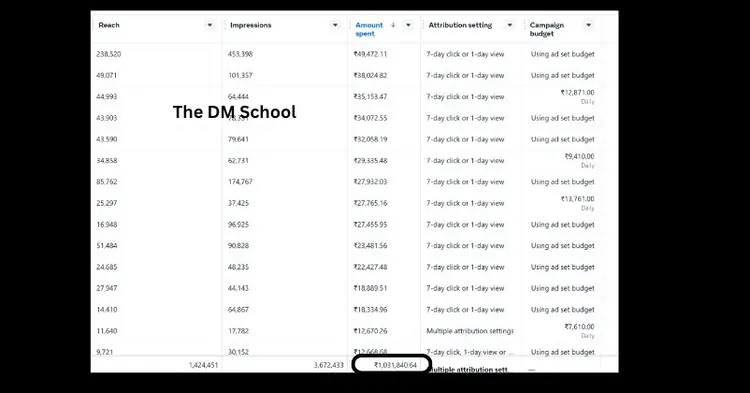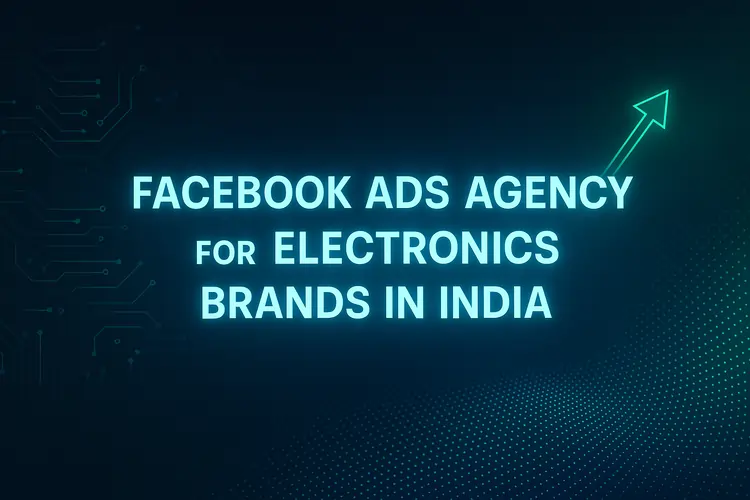Quick Takeaway: In India, precision targeting beats reach. Always focus on buyers, not clicks. 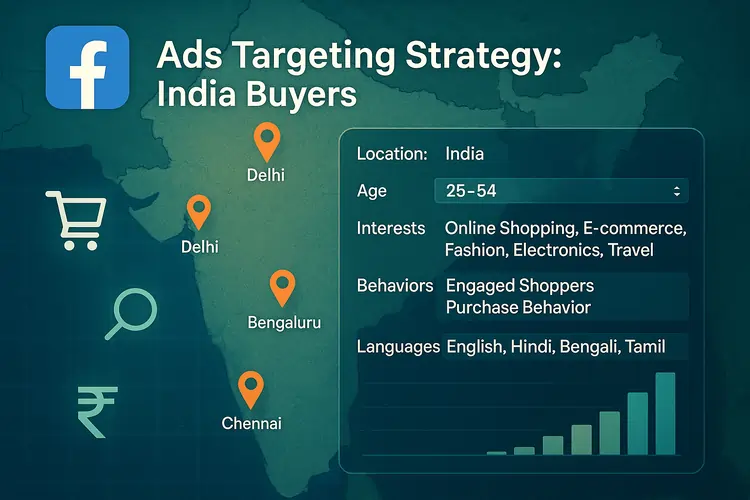
What is Facebook Ads Targeting?
Facebook Ads targeting is the process of selecting specific audience segments so your ads reach people most likely to take action.
It’s how Facebook decides who sees your ad. Instead of showing it to everyone, you define the audience by age, location, interests, and behavior.
In India, targeting is the difference between wasting budget and generating sales. When you focus on buyers, your campaigns deliver a far better return on investment.
Facebook collects vast amounts of user data — demographics, device usage, and activity patterns — to match ads with relevant users. As a marketer, your role is to guide this process with precision.
Our Facebook advertising services use these targeting options to create campaigns that are both cost-efficient and high-converting.
For example, if you run an online coaching business, you can target users in metros, aged 25–40, who follow specific industry leaders. This focuses spend on people who can afford and value your offer.
Quick Takeaway: Facebook targeting decides who sees your ad — choose wisely, and you’ll reach buyers, not browsers.
The Reality of Facebook Ads in India
Huge reach
India has one of the largest Facebook audiences.
Great for scale with precision filters.
Performance shift
Budgets keep moving to measurable digital.
Targeting quality decides returns.
Value media
Costs can be efficient with clean exclusions.
Waste creeps in without control.
What is buyer-focused targeting?
Select audiences that show intent, ability to pay, and timing signals. Exclude everyone else. The goal is profitable reach, not maximum impressions.
How to do it in India:
Map buyer signals, layer persona and behavior, narrow geos, add custom lists, and apply exclusions. Use conversion objectives and control frequency. Scale only campaigns that produce purchases.
4-Layer Targeting Framework (India)
- Market: city clusters, language, device realities.
- Persona: age bands, roles, income proxies, affinities.
- Signals: creators followed, recent engagement, custom audiences.
- Controls: exclusions, placements, frequency caps, conversion objectives.
Waste Kill Switches
- Exclude recent converters and low-quality engagers.
- Separate warm and cold journeys.
- Narrow geos to buyer pockets.
- Split Android/iOS if pricing differs.
- Remove ineligible interests and broad lookalikes early.
Want our proven workflow? See the
ad process.
Or let our
Facebook advertising services
implement it with
Google Partner
standards.
Quick Takeaway: Treat targeting as a system. Stack layers, enforce exclusions, and scale only what sells.
Why Targeting Buyers Matters More Than Getting Clicks
Clicks don’t pay the bills. Buyers do. In India, many advertisers chase vanity metrics — likes, comments, and impressions — while ignoring the one metric that truly matters: sales.
Every click costs you money. If the person clicking has no intent to purchase, that money is wasted. A buyer-focused strategy filters out non-buyers before they ever see your ad.
Unlike generic agencies that teach broad interest targeting to get more reach,
The DM School
uses refined targeting to reach smaller, high-value audiences. This means fewer wasted impressions and a stronger return on ad spend.
Broad targeting might inflate your click-through rate, but it dilutes conversion rates. Buyer targeting flips this — smaller reach, higher conversion, better profit margins.
Competitor Comparison
| Approach | Generic Agencies | The DM School |
|---|---|---|
| Targeting | Broad interest pools | Layered buyer signals + exclusions |
| Budget Efficiency | High spend, low ROI | Optimized for revenue per rupee |
| Conversion Rates | Lower, due to non-buyer clicks | Higher, from qualified traffic |
Definition: Buyer targeting means reaching people with intent and ability to purchase now. Click targeting focuses on anyone who might engage, regardless of intent.
How to shift from clicks to buyers: Use intent-based signals, narrow geos, refine personas, and apply exclusions. Test multiple buyer pockets and cut any ad set that attracts cheap but non-converting clicks.
Want this approach implemented for your campaigns? Our
Facebook advertising services
specialise in Indian buyer targeting that converts clicks into customers.
Quick Takeaway: Stop buying clicks. Start buying customers.
Core Targeting Layers in India
Successful Facebook Ads targeting in India works like layers in a funnel. Each layer narrows your audience, so your ads reach people most likely to buy.
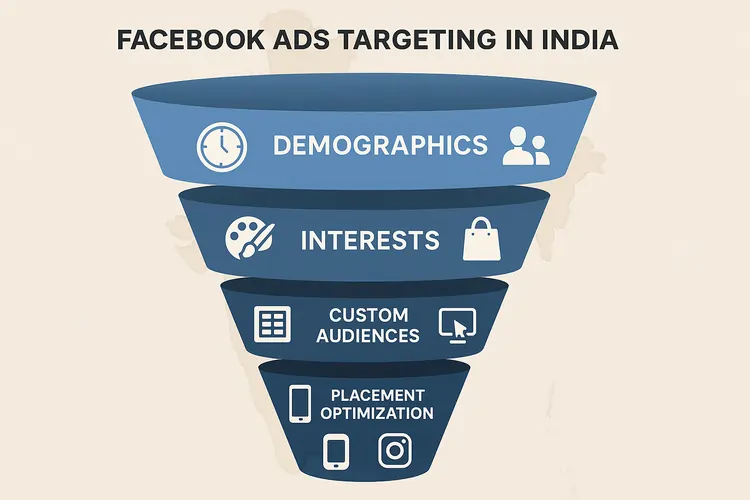
1. Demographics Layer
Choose age, gender, location, and language relevant to your product. City-based segmentation often works better than state-level targeting, especially for premium offers.
2. Interest Layer
Select interests closely connected to your niche. For example, a fitness brand could target people interested in workouts, nutrition, or popular fitness influencers.
3. Custom Audience Layer
Upload customer lists, retarget website visitors, or engage people who interacted with your posts. This builds warm audiences ready to buy.
4. Placement Optimization Layer
Choose placements where buyers engage most. In India, mobile feed and Instagram stories often drive better conversions than desktop placements.
Definition: Targeting layers are stacked audience filters that work together to deliver ads only to your ideal customers.
How to apply layers:
Start with broad demographics, add niche interests, retarget warm audiences, and fine-tune placements. Test each layer’s impact, then combine the best performers for maximum ROI.
Learn how we combine these layers in our ad process. Or let our Facebook advertising services build your campaigns with proven targeting frameworks.
Quick Takeaway: The more layers you stack, the sharper your targeting and the higher your conversions.
Advanced Buyer Targeting Tactics
Most guides won’t tell you this, but finding buyers on Facebook in India isn’t about picking random interests. It’s about working with Facebook’s algorithm, removing wasted impressions, and feeding it the right signals to lock onto purchase-ready users.
1. Competitor Audience Targeting
Target users who follow or engage with your competitors’ Facebook or Instagram pages. These people are already in the buying mindset for your category.
Execution: In Ads Manager, go to Detailed Targeting → Interests → search your competitor brand names or industry-specific publications.
Why it works: It leverages buyer intent already created by someone else’s marketing budget.
Pro Tip: Run dynamic creatives so these users see fresh variations instead of static ads they might ignore.
2. Layered Interest + Behavior Combos
Combine a core interest with a purchase-oriented behavior for ultra-specific targeting.
Example: “Fitness Enthusiasts” + “Engaged Shoppers” or “Parents of Teens” + “Online Payment Users.”
Execution: Use Narrow Audience in Detailed Targeting to ensure both conditions must be true.
Why it works: You get people who want what you sell and have a history of acting on ads.
Pro Tip: Keep audience size above 2–3 lakh to give the algorithm room to optimize.
3. Exclusion Targeting
Remove users who are unlikely to buy, even if they engage.
Example: People who clicked “Get Offer” in past campaigns but never purchased.
Execution: Create a Custom Audience of non-buyers from your CRM or website pixel, then exclude it in new campaigns.
Why it works: It prevents budget from being eaten by habitual freebie seekers.
Pro Tip: Also exclude frequent coupon hunters for premium products.
4. Buyer Pocket Segmentation
Break your campaigns into micro-markets based on cities, professions, or language groups where buyers are concentrated.
Example: Separate ad sets for Bangalore English-speaking tech professionals, and for Mumbai Hindi-speaking business owners.
Execution: Duplicate your best-performing ad set and change only the location or language to test buyer pockets.
Why it works: It lets you bid more aggressively where ROI is proven instead of spreading budget thin.
Pro Tip: Use localised creatives to match the culture and tone of each pocket.
Definition: Advanced buyer targeting means refining audiences using proven buying signals, exclusions, and niche segmentation to maximise conversion rates while cutting wasted impressions.
How to use advanced tactics:
Start with your strongest audience, test one refinement at a time, and keep only what improves ROAS. Layer winning tactics for compounding results.
Want these tactics applied to your campaigns? Our Facebook advertising services help Indian businesses cut ad waste and double ROI using data-backed targeting methods.
Quick Takeaway: Deep targeting may shrink your audience, but it grows your profit.
Budget Allocation for Buyer-Focused Campaigns
Targeting buyers is only half the job. The other half is smart budgeting.
Allocate spend by intent. Then adjust weekly based on results.
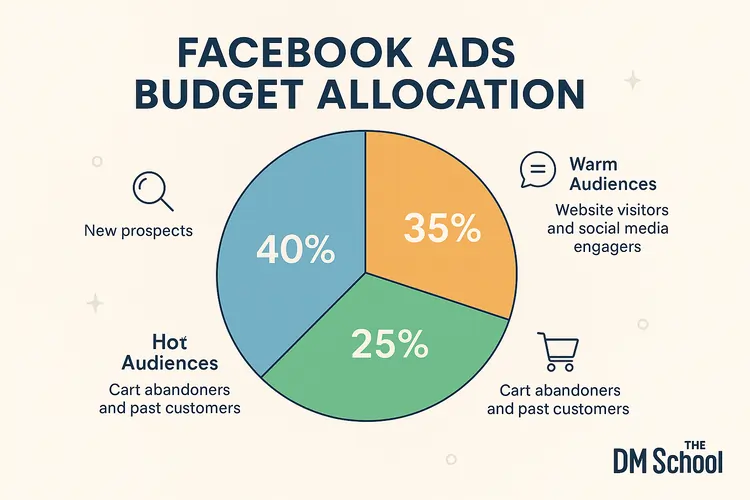
40% — Cold Audiences
New prospects who match your buyer profile.
Use broad layers and strong hooks to attract.
35% — Warm Audiences
Visitors, engagers, and video viewers.
Show problem-solving content and clear benefits.
25% — Hot Audiences
Cart abandoners, leads, and past customers.
Use strong offers and urgency to close.
Definition: Buyer-focused budgeting gives more spend to high-intent segments while still feeding cold discovery.
How to allocate effectively: Start with 40-35-25. Monitor ROAS weekly. Shift budget toward warm and hot if costs drop. Refresh cold every 2–3 weeks to prevent fatigue.
We use this budget model in our
Facebook advertising services
to scale without waste.
Quick Takeaway: Fund intent first. Keep cold fresh to feed the funnel.
Common Mistakes in Facebook Ads Targeting (India-Specific)
Even experienced advertisers waste budget because of a few recurring mistakes. Avoid these and your campaigns will instantly become more efficient.
Mistake 1: Boosting Posts Instead of Running Targeted Campaigns
Why it’s a problem: Boosted posts prioritise engagement, not conversions. They often attract likes and comments from people with no buying intent.
Fix: Use Ads Manager to run campaigns with a “Conversions” or “Leads” objective. This gives the algorithm clear purchase goals.
Mistake 2: Over-Broad Targeting
Why it’s a problem: Huge audiences dilute your message and waste budget on people unlikely to buy.
Fix: Narrow down by combining interests, demographics, and behaviors. Keep audience sizes manageable — around 2–5 lakh for most Indian niches.
Mistake 3: No Exclusions
Why it’s a problem: Without exclusions, you keep showing ads to past buyers or low-quality leads, increasing costs without results.
Fix: Exclude recent converters, unqualified leads, and competitors’ employees. This ensures your budget only hits potential buyers.
Mistake 4: Ignoring Placement Performance
Why it’s a problem: Different placements perform differently in India. Wasting spend on low-performing placements drags down ROAS.
Fix: Track results by placement. In many cases, mobile feed and Instagram Stories outperform desktop placements.
Definition: Targeting mistakes are choices in campaign setup that reduce efficiency, increase costs, and lower conversions.
How to avoid them:
Audit campaigns weekly. Use data to refine targeting, remove waste, and double down on proven audience segments.
We spot and fix these mistakes in every account we manage. If you want a clean, efficient targeting setup, explore our Facebook advertising services.
Quick Takeaway: Small targeting errors add up to big losses. Fix them early for better ROI.
How The DM School Compares to Other Agencies
When it comes to Facebook Ads targeting in India, not all agencies follow the same approach. Here’s how The DM School stacks up against typical providers.
| Feature | Generic Agencies | The DM School |
|---|---|---|
| Targeting Strategy | Broad interests, minimal exclusions | Layered buyer signals, geo-targeting, and strict exclusions |
| Audience Segmentation | One-size-fits-all campaigns | Micro-market segmentation with tailored creatives |
| Data Tracking | Basic metrics only | Deep analytics, placement performance, and ROAS optimisation |
| Ad Creative Approach | Static creatives reused across audiences | Dynamic creative testing with audience-specific messaging |
| Budget Efficiency | High spend with low return | Optimised for revenue per rupee spent |
Why This Matters: Every rupee counts. With precise targeting, creative testing, and strict data tracking, The DM School turns Facebook Ads into a predictable revenue driver.
Definition: Competitor comparison is the process of highlighting key service differences to help buyers choose a provider with the best ROI potential.
How to read this table:
Look for strategies that reduce waste, improve targeting accuracy, and tie ad spend directly to revenue growth.
Work with an agency that treats your budget like its own. See our Facebook advertising services for results-driven campaigns.
Quick Takeaway: Small strategic differences between agencies can mean the difference between scaling profitably and burning budget.
Step-by-Step Facebook Ads Targeting Framework for India
Follow this framework. Reach buyers, not browsers.
Each step builds on the last. Your budget works harder.
1. Define your buyer persona
Note age, city, language, income, and interests.
Use past sales data. Add survey insights.
Study our ad process for structure.
Pro Tip: Split by city tier and language. Behavior changes fast.
2. Map to Facebook options
Open Ads Manager. Go to Detailed Targeting.
Match persona to demographics, interests, and behaviors.
Validate size in Audience Insights. Adjust if tiny.
Pro Tip: For B2B, test roles, industries, and tool interests.
3. Layer and narrow
Combine at least two filters.
Example: “Fitness Enthusiasts” AND “Engaged Shoppers.”
Keep size above 2–3 lakh. The algo needs room.
4. Apply exclusions
Exclude buyers, weak leads, and competitor staff.
Cut habitual freebie seekers for premium offers.
This protects CPA. Waste drops quickly.
5. Test and optimise
Run multiple ad sets. Small daily budgets.
Let them run 3–5 days. Avoid rushing.
Check CPL and ROAS. Use Breakdown reports.
6. Scale what works
Increase budget 20–30% at a time.
Add fresh creatives. Prevent fatigue.
Duplicate winners. Test slightly broader pockets.
Definition: A targeting framework guides you from discovery to profitable focus.
How to use this:
Follow steps in order. Test first. Scale later. Audit weekly.
We use this system in our Facebook advertising services.
It aligns with our Google Partner standards.
Quick Takeaway: Structure beats guesswork. Your rupees reach real buyers.
🎯 Ready to Target Buyers, Not Just Clicks?
Stop wasting budget on broad audiences. Let The DM School build a Facebook Ads strategy that reaches the right buyers from day one.
Our Facebook advertising services use layered targeting, data-backed optimisation, and buyer signals to deliver measurable ROI.
No spam. No wasted spend. Just results.
